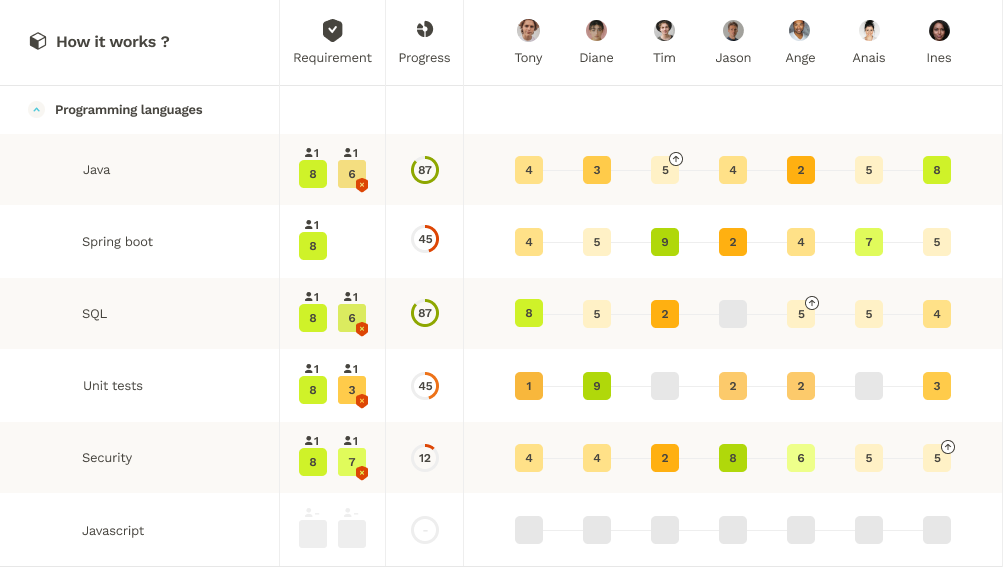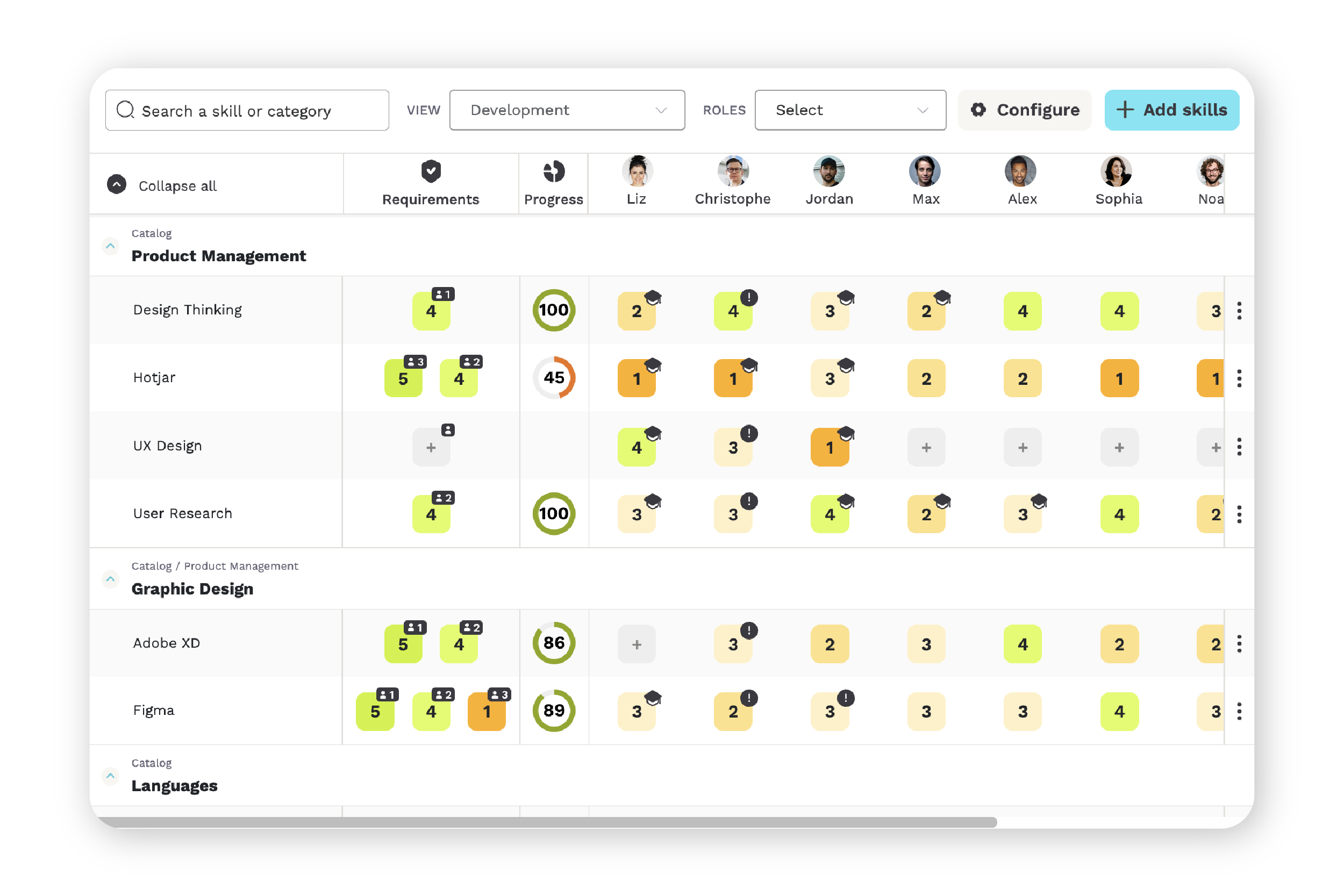Using a Skill Matrix can help unlock the potential in your team and organization. This powerful tool is designed to bridge the gap between your current skills and those you need to succeed – by providing an accurate overview of all the competencies.
It’s a simple yet effective way to identify areas of improvement, set clear goals, provide tailored training programs and value employees who are learning. With its detailed analysis and data-driven insights, this innovative approach can help you build a better workplace culture while providing employees with the opportunity to develop their technical, professional and leadership skills.
Read on to find out more about how you can benefit from a skill matrix!
Overview of the Skill Matrix
Definition
A Skill Matrix, also known as a competency matrix, is a tool used by organizations to assess, manage, and visualize the skills and competencies of their employees. It provides a structured way to identify which skills are present in a team or organization, which skills are lacking, and where there might be gaps in expertise that need to be addressed.
It was known as a standard tool for managers until a competency matrix has been proposed in the Management 3.0 toolkit by Jürgen Appelo in 2010, enabling agile teams to use with the entire team.
A Skill Matrix or competency matrix visualizes and tracks the competency levels for employees. You can assess in the skill matrix various skills required in your teams. These can be hard skills but also soft skills like communication and conflict solving.
A Skill Matrix can be used to map out entire teams and/or departments, making it easy to identify areas of opportunity for training and development.
Why is Skill Matrix so important?
The success of teams depends above all on their skills! Without the right skills, your team will be slower and deliver less quality, or worse, be completely blocked.
The key benefits of a skill matrix are:
- Identifies skill gaps: You can determine exactly what kind of skills are required and decide actions to improve skills in your teams.
- Ensure compliance: The skill matrix helps you to ensure your team has the mandatory knowledge for compliance topics like security, data protection or safety at work.
- Incentivizes development: Seeing where they stand compared to peers encourages individuals to work hard and improve themselves.
- Fosters collaboration: By understanding one another’s abilities, it makes it easier for team members to work together efficiently.
- Improves hiring quality: By knowing which skill is missing in your team, you can better target the required employee profiles and evaluate them during an interview.
Creating a Skill Matrix
Identifying the necessary skills
Before constructing a skill matrix, it’s important that you first list out the most essential skill sets required for your team.
I recommend asking your team to list on a board all the tasks that have to be performed. And then give your team an additional 10 minutes to brainstorm the required skills.
The difference between skill and ability
Skill and ability are so close in meaning that they can be used as a synonym. We can only distinguish them by stating that an ability is a more natural aptitude.
As a simple rule of thumb, add in the matrix skills that people can easily learn. If you consider the skill “creativity”, you can learn creativity techniques, but it is more difficult to become a creative person. So prefer using the term “creativity techniques”.
You can read more about the difference between ability and skill in this article.
Strategic skill development
As it may take several months to upskill people in your team, it is important to consider not only the current skill needs, but also the skills you will need for the next years.
As we currently see a boom in artificial intelligence, companies which have started to develop their skill during the last years are getting now a competitive advantage. Developing skills requires a great investment, and you should have a strategic approach for your skill development.
Ask your product owner and stakeholders how the strategic product development looks like, and add to your matrix the skills that are critical for your future business.
Choose the right skill granularity
When creating a skill matrix, selecting the appropriate level of granularity for skills is crucial to ensuring its effectiveness. If the skills are too broadly defined, the matrix may lack the specificity needed to accurately assess and develop team competencies. On the other hand, overly granular skills can lead to a cluttered matrix that’s difficult to maintain and interpret.
Te key is to strike a balance by categorizing skills at a level that is detailed enough to capture important distinctions but broad enough to avoid overwhelming complexity. Consider the team’s objectives and the purpose of the matrix—whether it’s for project assignments, training, or career development—and tailor the granularity accordingly.
Finding the right proficiency scale
Choosing the appropriate proficiency scale is a critical part of the skill matrix design. A short scale of 3 levels is faster to use. A larger one will let your team define more accurately skill levels and fosters smaller steps in the development. In this article, you can find some help to choose your right proficiency scale.
Using a template or tool to create a Skill Matrix
Fortunately, creating your own skill matrix doesn’t have to be complicated. There are various templates available online as well as specialized tools designed specifically for this purpose.
A software is especially helpful when dealing with large teams or departments, as it provides an efficient way of tracking the development of each individual.
Each tool brings its own management philosophy and framework. When you are looking for software for the future of work, then the skill matrix from Teammeter is the right choice for you. With Teammeter, teams participate actively in the skill matrix and take ownership of their development.

Utilizing a Skill Matrix
Assessing the skill levels
To be effective, the assessment of skill levels has to be done individually and collectively.
First, ask your team members to assess individually their skill levels in their skill profile. The description of expectations at each skill level helps the employee to select the right level.
In a second step, ask your team to review the levels for other members. This is the opportunity to exchange feedback to have a better assessment of skills.
Because of the Dunning Kruger effect, a psychological bias, people may assess themselves too optimistically when they not yet know the real expectations related to a skill. People with a higher skill level can then help their colleagues to better estimate what is required to achieve a higher skill level.
Calculating the bus factor
The bus factor, or sometime called truck factor, is the minimum number of team members who have to suddenly disappear from a project before the project stalls due to lack of knowledgeable or competent personnel.
The bus factor can be calculated for each skill: it is the number of team members with a skill level higher or equal than the skill level of the team.
The team skill level is the required level to be able to perform the related tasks. Assess the overall skill level for the team, depending on the complexity level of the tasks.
The overall bus factor for your team is then the minimum bus factor for all skills. The higher the bus factor is, the better. Teams should have ideally a bus factor of 3, this means even one person is on holiday, a sick leave won’t impact the delivery of the team.
Skill requirements
You may need to define more accurately skill requirements, with the number of persons required for each skill level. For instance:
- The number of people generally involved in a particular task
- The skill level required for the “backup” team members.
For that purpose, you can enter the skill matrix the number of people required for each skill level.
Identifying skill gaps and opportunities for development
Once you have created your skill matrix, you can begin using it to identify any potential gaps or weaknesses within your team. This information can then be used to focus on developing specific technical abilities or providing additional training sessions to ensure employees are meeting desired competencies.
You should review the skill matrix at least every 3 months to track the development progress in your team.
Support knowledge sharing between team members
The Skill Matrix is not only used to show the skill proficiency levels within the team, but also to show the development needs for each team member.
To make clear, which team member would like to learn a particular skill, we indicate it in the matrix with an upward arrow close to the skill level.
In a team meeting, ask who is willing to help colleagues wanting to learn a skill and plan the knowledge transfer activities.
Making a skill development plan
Identifying gaps is good, deciding actions to handle these gaps is better. You should end a skill matrix review with a list of actions decided with your team to increase the knowledge in your team.
Here are examples of actions that can be decided with your team:
- Organize a knowledge transfer session within the team
- Record a video on a particular topic and share it with the team
- Participate in a training
- Give a challenging task to a team member, which is not used to do. For instance, performing a presentation or being involved in sales.
Use the collective intelligence of the team to find such actions. Your team members may have great ideas how to share knowledge.
Using the Skill Matrix for hiring
Now that the skill gaps are visible, you can better identify the ideal candidate profile for your team. The candidate must match the minimum skill requirements, in particular for soft skills, and bring the missing skills that will bring your team to higher performance.
Conclusion
The Skill Matrix is an essential tool for teams, as it helps to make the right decisions to accelerate the skill development. With the appropriate skills on board, you have the best foundation for your success.

